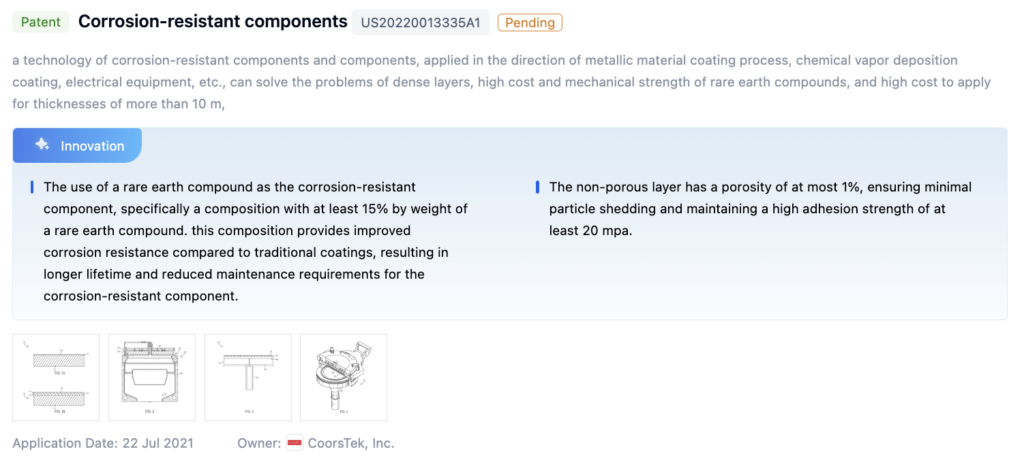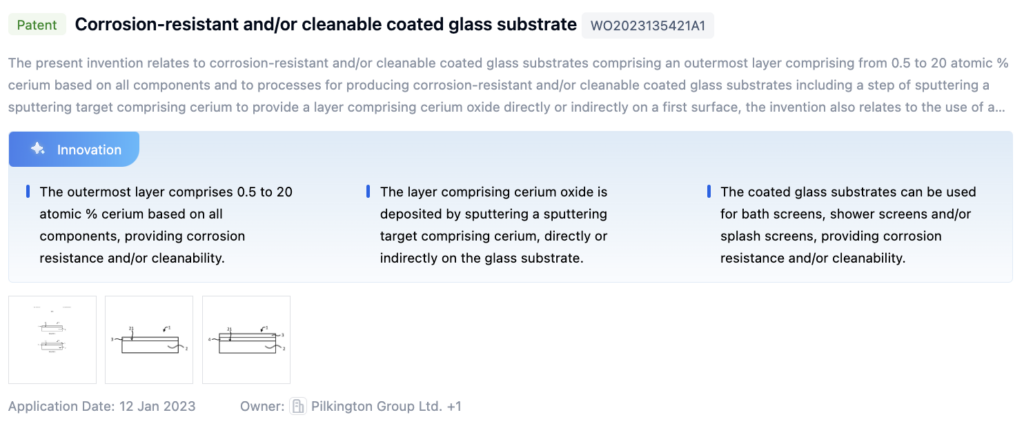
Ceramic Coatings Corrosion Resistance Goals
Improving the corrosion resistance of ceramic coatings is crucial in industries such as aerospace, automotive, and energy. These coatings protect metallic components from harsh environments, including high temperatures, corrosive media, and wear. However, factors like thermal cycling, chemical attack, and mechanical stresses can compromise their long-term durability.
The primary objective is to develop ceramic coatings with enhanced corrosion resistance, enabling longer service life and improved reliability of coated components. This can be achieved through optimizing coating composition, exploring novel deposition techniques, and incorporating advanced surface treatments.
Key areas of focus include:
- Composite Ceramic Coatings: Combining multiple ceramic materials like alumina or zirconia in thermal barrier coatings to improve corrosion resistance while maintaining high-temperature capabilities.
- Self-Healing Mechanisms: Integrating self-healing agents or leveraging the intrinsic self-healing properties of certain ceramic materials to repair cracks or defects autonomously.
- Surface Modification Techniques: Using ion implantation, laser peening, or plasma nitriding to enhance the corrosion resistance by altering surface chemistry, introducing compressive stresses, or creating protective surface layers.
The goal is to develop coatings that withstand prolonged exposure to corrosive environments while maintaining functional properties like thermal insulation, wear resistance, and oxidation protection, leading to improved performance, reliability, and cost-effectiveness across industries.

To get detailed scientific explanations of the ceramic coatings, try Patsnap Eureka TechResearch.
Market Demand for Corrosion-Resistant Ceramic Coatings
The demand for corrosion-resistant coatings spans various industries requiring protection against harsh environments, such as:
- Oil and Gas: Coatings protect equipment from corrosive gases like hydrogen sulfide and carbon dioxide, extending the lifespan of pipelines and offshore platforms.
- Chemical Processing: Coatings ensure safe and efficient operations by protecting equipment from aggressive chemicals, minimizing the risk of leaks and failures.
- Power Generation: Coastal or high-humidity environments require coatings to protect boilers, turbines, and critical components from moisture and atmospheric pollutants.
- Marine Industry: Coatings protect ships and offshore structures from the harsh saltwater environment, extending service life and reducing maintenance costs.
- Infrastructure: Bridges, buildings, and transportation systems benefit from coatings that protect steel and concrete structures from environmental factors, ensuring long-term durability.
Overall, the market demand is driven by the need for reliable solutions to protect critical assets from corrosion-related failures. As industries seek to extend the lifespan of their assets, the demand for advanced corrosion-resistant coatings is expected to grow steadily.
Current State and Challenges in Ceramic Coatings

Ceramic coatings are valued for their high hardness, wear resistance, and thermal stability, but challenges in corrosion resistance remain:
- Porosity and Defects: Pinholes, microcracks, and other defects formed during deposition can allow corrosive agents to penetrate and degrade the coating.
- Chemical Stability: Some ceramics, like oxides and nitrides, may degrade in acidic or alkaline environments, leading to dissolution or weakening of the coating.
- Adhesion Issues: Poor adhesion can lead to delamination, exposing the substrate to corrosion. Thermal expansion mismatches between the coating and substrate can exacerbate this problem.
- Environmental Factors: High humidity, proximity to coastal areas, and industrial pollutants can accelerate the degradation of ceramic coatings.
Addressing these challenges requires advancements in deposition techniques, material selection, surface engineering, and post-treatment processes.
Evolution of Ceramic Coating Technologies

Existing Solutions for Corrosion Resistance
Ceramic Coatings with Enhanced Corrosion Resistance
Various ceramic coatings have been developed to provide improved corrosion resistance using materials like silicates, oxides, or nitrides, applied through thermal spraying, sol-gel methods, or controlled oxidation processes.
Ceramic Composite Coatings
Composite ceramic coatings incorporate reinforcing materials like nanoparticles, graphene, or carbon fibers to enhance durability and protection against corrosion and wear.
High-Temperature Corrosion-Resistant Coatings
They designed to withstand high-temperature environments involve materials that resist oxidation, sulfidation, and other forms of high-temperature corrosion.
Environmentally Friendly Coatings
Efforts are made to develop eco-friendly ones that minimize harmful substances while providing effective corrosion protection.
Preparation Methods
Techniques like thermal spraying, sol-gel methods, and slurry coating are employed to achieve uniform, adherent, corrosion-resistant ones.
Composite Ceramic Coatings
These coatings combine ceramic materials with other components to create a protective layer offering superior resistance to corrosion in specific environments.
Key Players in Ceramic Coating Industry
Murata Manufacturing Co. Ltd.
Developed advanced ones with enhanced corrosion resistance by incorporating nanomaterials and advanced surface treatments.
Siemens Energy Global GmbH & Co. KG
Introduced a proprietary ceramic coating technology using high-temperature plasma spraying, ensuring uniform and dense coatings with superior protection.
Institute of Metal Research, Chinese Academy of Sciences
Focused on developing ceramic coatings with improved corrosion resistance using advanced material science techniques and rare earth elements.
Lanzhou Institute of Chemical Physics
Developed ceramic coating technology incorporating self-healing properties to autonomously repair minor damages, extending the lifespan of the coating.
ZYP Coatings Inc.
Specializes in high-performance ceramic coatings offering excellent corrosion resistance, using advanced binders and fillers for robust and durable coatings.
Core Innovations in Ceramic Coatings
Patent 1: Corrosion-Resistant Components
- Use of Rare Earth Compounds: Improved corrosion resistance compared to traditional coatings, reducing maintenance requirements.
- Non-Porous Layer: Ensures minimal particle shedding and high adhesion strength.

Patent 2: Corrosion-Resistant Coated Glass Substrate
- Cerium Oxide Layer: Provides corrosion resistance and cleanability, applied through sputtering.
- Application: Suitable for bath screens, shower screens, and splash screens.

Paper 1: Corrosion Resistance of ZrO2 and Al2O3 Ceramics
- Review: Covers corrosion resistance of these ceramics in various environments.

Potential Breakthroughs in Corrosion Resistance
Ceramic Coatings with Combined Corrosion and Wear Resistance
Designed for applications where both corrosion and wear are concerns, offering protection against abrasive environments.
Ceramic Coatings for High-Temperature Corrosion Resistance
Suitable for high-temperature environments, providing protection against oxidation, sulfidation, and other forms of high-temperature corrosion.
Evaluation and Testing of Corrosion Resistance
Various methods, including accelerated corrosion tests and electrochemical techniques, are used to assess the performance and durability of ceramic coatings.
Environmental Impact of Ceramic Coatings
They offer benefits like extending component service life and reducing waste, but their production and disposal can have environmental impacts. High-temperature processes can be energy-intensive, and certain materials may pose environmental risks if not properly handled. Mitigating these impacts involves optimizing manufacturing processes, developing environmentally friendly formulations, and exploring recycling options.
Regulatory Landscape for Coating Technologies
They must comply with regulations like those from the Environmental Protection Agency (EPA), which focuses on minimizing VOC emissions and hazardous air pollutants. The Occupational Safety and Health Administration (OSHA) also sets standards for worker safety in coating applications. International standards like ISO and REACH regulations are crucial for companies operating globally, ensuring product quality and compliance. Staying informed about regulatory changes is essential for maintaining competitiveness in the market.
If you want in-depth research or a technical report, you can always get what you want in Patsnap Eureka TechResearch. Try now!

